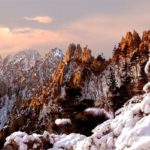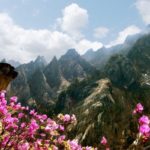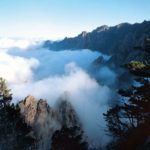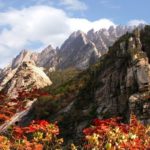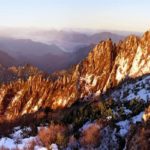Mt. Kumgang is one of the six celebrated mountains in Korea. It numbers among the renowned mountains of the world.
People who have been to Mt. Kumgang advise others not to say about the beauty of any famous mountains in the world before visiting it.
The mountain, located midway down the east coast of Korea, extends 60 km north and south and 40 km east and west. It covers an area of 530 km² in Kangwon Province including Kosong, Kumgang, Thongchon counties.
A compound of all descriptions of natural beauties–mountain peaks, ravines, plateaus, distant views, lakes, seas and coasts.
The view of the mountain with its 12 000 soaring peaks looks like a picture scroll disclosing a wonderful harmony of myriad scenes and shapes. From olden times the mountain has been called in various names because of the variation of its scenes by the season, time of day and weather, in addition to its superb beauty. It is said that in spring, when all flowers are in full bloom emitting a sweet fragrance, it was called “Kumgangsan” in allusion to the diamond, the most beautiful jewel; in summer, when white clouds settle on the peaks and cliffs, with the forests in fresh verdure, birds chirping and the roar of the waterfalls filling the air, it was called “Pongraesan”; in autumn, when the leaves turn red and the blue streams flow down the ravines, it was called “Phungaksan”; in winter, when the whole mountain is covered with snow and ice, it was called “Kaegolsan”.
The highest peak in Mt. Kumgang is Piro Peak(1 639 m).
Mt. Kumgang is varied in its natural beauty and each section of it has peculiar scenery. It is divided broadly into Inner Kumgang, Outer Kumgang and Sea Kumgang.
Besides the scenic spots and interesting legends, many places of historical interest add to the fame of Mt. Kumgang. Mt. Kumgang has also a wide variety of fauna and flora. It is a home to over 2 250 species of plants.
Included in the 100 species indigenous to the mountain are Kumgang pentactina rupicola, Kumgangania asiatica, Androsace cortusaefolia and so on. It is inhabited by 38 kinds of animals, 130 kinds of birds, 9 kinds of reptiles, 10 species of amphibians and 30 species of fish.
The average annual temperature is 11℃ and the average annual precipitation is 1 500 mm.

